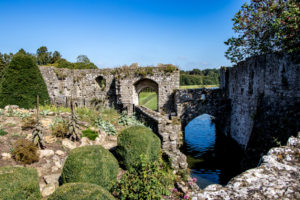Invergarry Castle in the Scottish Highlands was the seat of the Chiefs of the Clan MacDonell of Glengarry, a powerful branch of the Clan Donald.
The castle’s position overlooking Loch Oich on Creagan an Fhithich – the Raven’s Rock – in the Great Glen, was a strategic one in the days of clan warfare. It is not certain when the first structure was erected on Creagan an Fhithich but there are at least two sites prior to the present castle.
After raids by the Clan Mackenzie in 1602 which included the burning of Strome Castle, the MacDonalds of Glengarry fortified Creagan an Fhithich. The result was an imposing six-story L-plan tower house, although the exact form of the earlier castle is not known. According to clan tradition, the castle was built with stones passed hand to hand by a chain of clansmen from the mountain Ben Tee.
During the Civil War Oliver Cromwell’s troops under General Monck burned the castle down in 1654. Repaired, it was held for King James VII of Scotland from 1688 until its surrender to the Government forces of William and Mary in 1692. It was then held by the Jacobites during the 1715 uprising, but taken for the government in 1716. During the 1745 uprising, it was again held by Jacobites and visited twice by Bonnie Prince Charlie.
During the Jacobite risings of 1745 to 1746, Prince Charles Edward Stuart – “Bonnie Prince Charlie” – visited the Castle shortly after the raising of the Royal Standard at Glenfinnan and is said to have rested there after his defeat at the Battle of Culloden, in 1746. The MacDonell’s were closely involved throughout the Jacobite risings, Lord MacDonnell being a Member of the Prince’s Council. In the aftermath of Culloden, the castle was sacked and partially blown up by troops under the Duke of Cumberland as part of his systematic suppression of the Highlands.
However, the stout walls refused to yield and have survived the centuries to serve as a reminder of their history. More prosaically, the Duke of Cumberland’s men no doubt felt that they had ‘slighted’ the castle sufficiently by removing the SE wall and demolishing the NW ‘L’ extension. The castle was never rebuilt, being abandoned by the MacDonell’s in favor of a new Invergarry House. This seems to have been commenced within a few years, Richard Pococke reporting this on his 1760 tour.
The Glengarry estates were sold by Aeneas Ranaldson MacDonell of Glengarry, the son of Alexander Ranaldson MacDonell of Glengarry (1771–1828) when he came of age, but he retained Invergarry Castle, Invergarry House, the “Well of Heads” and the ancient clan burial ground, which instead passed through Aeneas’s daughter to the Erskine Cuninghames of Balgownie and Corrie.







